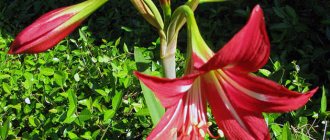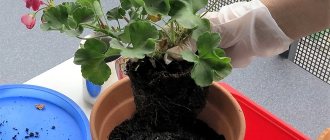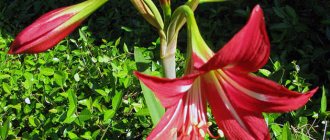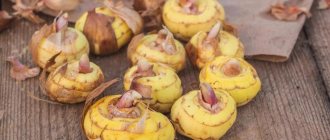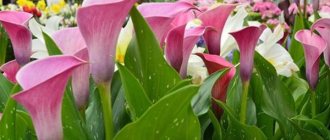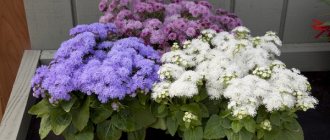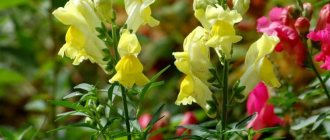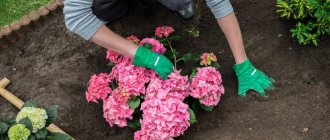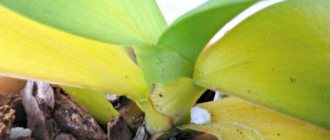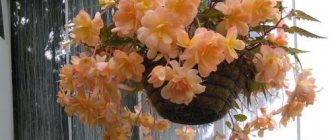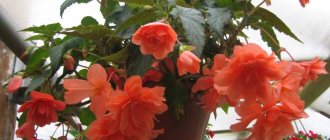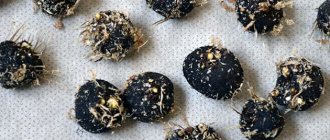As a rule, it is used in breeding to develop new varieties and hybrids. When propagating a variety by seed, 100% compliance with the parent form in seedlings is not guaranteed. Self-pollination does not provide a 100% guarantee that the same variety will be obtained. There are species that cannot self-pollinate. This method of reproduction is the most labor-intensive and time-consuming. An onion grown from seeds blooms with good care in the 5th-6th year.
The pollination process is simple: the stigma of a flower of one variety of hippeastrum is pollinated with pollen of other varieties, pollinated several times from the moment the stigma lobes diverge until complete divergence.
Only healthy bulbs are selected for pollination.
It takes about 1.5-2 months for the seeds to ripen. Seeds can be collected when the seed pod begins to open. Not all seeds are suitable for planting; there are “dummy” seeds (that is, there is no embryo inside), so the seeds are sorted before planting. The largest, plumpest seeds are selected (the embryo can be felt to the touch). The sorted seeds can be sown in the ground, lightly sprinkled with soil, or placed in water (with activated carbon) and wait for germination; as soon as the white root emerges, plant it in the ground (with the white root down). The distance between seeds when planting is 1.5-2 cm.
For seed germination and seedling growth, light, warmth and proper watering are important. The soil should be slightly moist, temperature 20-23 degrees. If these conditions are not met, the seeds may not germinate or may rot. The germination rate of fresh seeds is almost 100%.
Seedlings need to be transplanted as they grow. Don't forget to apply fertilizer.
Spring seedlings are stronger than autumn ones, so seed propagation is best done in the spring. In addition, autumn seedlings need additional lighting in winter.
Reproduction of hippeastrum by children
This method allows you to preserve all varietal characteristics, but the reproduction rate is low. Children are formed irregularly. The formation of children largely depends on the variety, for example, La Paz and Giraffe seabirds easily produce children, but terry varieties are reluctant.
The babies are separated from the mother's bulb during transplantation. When separated, the baby should be at least 2 cm, with good roots. With good care, children bloom in the 4th year.
Transfer
To repot a plant, first select a container.
Choose a pot that is several centimeters larger in diameter than the previous one. Do not take containers that are too spacious, as in this case the plant will spend energy on producing babies rather than flowering. There should be a distance of maximum 2 cm between the walls of the container and the bulb. The culture has a powerful and well-growing root system, and therefore it is better to choose a low but wide container. In addition, some specimens reach a large weight, and a container made of lightweight materials may not support the mass of the flower. For group planting, a long container is suitable; in this case, the gap between the bulbs should be 10 cm.
You also need to prepare the ground. The most favorable soil structure for culture is loose. To achieve a high-quality soil composition, combine in equal parts:
- turf land;
- leaf soil;
- humus;
- sand.
Prepare the onion.
- Take out the planting material, clean the head from dry scales to clean white tissue. The cleansing procedure will rid the bulb of bacteria and activate full development.
- Remove damaged and dry roots.
- Place the peeled onions in a solution of potassium permanganate for half an hour, and then dry well.
- If there are small children, they are eliminated so that they do not take away the strength of the parent bulb. If the grower plans to propagate the crop, then the children should be saved and then transplanted into a separate container, where they will begin to bloom in the third year.
When everything is ready, you can proceed directly to the transplant. It is done step by step.
- Create drainage at the bottom of the pot, for example, from expanded clay or crushed bricks. You can also put one stick of complex fertilizer there.
- Fill the container with soil.
- Plant the bulb in the ground. This should be done in such a way that the onion protrudes 1/3 above the surface.
- Compact the soil around the plant and moisten the soil.
- Place the pot in a well-lit, warm place.
For information on how to replant hippeastrum, see below.
Important Tips
- Before immersing the bulb in the soil, place it in a container of warm water for two hours.
- At the bottom of the pot, be sure to make a drainage of about three centimeters.
- Fill the soil on top so that the bulb protrudes above the soil surface by a third of its length. Place it strictly in the center of the pot, add soil and moisten it a little.
- You cannot water the plant right away. The first watering is done only after dormancy, when the sprout appears. As the peduncle grows, watering needs to be increased.
- When the sprout reaches fifteen centimeters, moisten the ground once with a weak solution of potassium permanganate. A week after this, feed the hippeastrum with phosphorus fertilizers.
As a rule, flowering occurs a month after the arrow appears. As soon as the hippeastrum begins to bloom, feed the bulb regularly, otherwise it will greatly decrease in size. If you want to extend the flowering time of hippeastrum, then place the pot in a cool but well-lit place.
Hippeastrum, methods of reproduction
Hippeastrum reproduces by seed and vegetative methods.
Seed method of propagation of hippeastrum
- The seed propagation method is a labor-intensive and time-consuming process, usually used by breeders to develop new hybrid varieties.
- As is known, propagation by seeds does not provide a 100% guarantee of the similarity of the parent and child forms.
- A plant grown from seeds will bloom only in the 5-6th year.
- Considering that some forms of hippeastrum are self-pollinating plants, artificial pollination of plants must be carried out in order for seeds to appear.
- When the seed pod begins to crack, you can collect the seeds. After collection, the seeds are sorted, selecting the largest and densest specimens. It is not worth storing seed material for a long time, because... it quickly loses its viability.
- Seeds are planted in a light soil substrate or left in a moist environment for germination. When the root appears, the seeds are planted in a container.
- Caring for seedlings includes providing the container with seeds with water, light and heat (20-23C). It is best to moisten the soil using a spray bottle.
- As the seedlings grow, they are picked and planted in separate containers.
Vegetative method of propagation of hippeastrum
- This method of reproduction is considered simpler and more accessible. In this case, the plant completely retains the characteristics of the parent form.
- If “babies” form on the bulb, they are separated (when digging up the bulb) and planted separately in the spring. Every year the “babies” grow, and already in the 4th year hippeastrum can please you with flowering. Caring for “babies” in the open ground is no different from the conditions for growing adult plants.
Another method of propagation is dividing the bulb, but this method is not very popular, because you have to cut a healthy onion, which can then become diseased and disappear. If you decide to use this method, first cut off the high bottom of the mother (thoroughly washed) bulb, then cut the bulb vertically into 8-10 parts
It is important that the resulting onion segment is at least 1-2 cm. After this, each segment is again cut into several divisions, including 2 scales
Before planting, all cuttings are treated in any fungicidal solution. The prepared cuttings are planted in boxes with a light, nutritious and moist substrate (perlite, sawdust, sand, peat) for further germination. The thickness of the substrate must be at least 10 cm. When planting, the divisions are not buried, leaving 1/4 of the part on the surface. It is important to maintain the soil temperature within 22-230C and provide the plantings with regular but moderate watering. After about a month, daughter bulbs form on the divisions, and after 3 months, full-fledged daughter bulbs are ready for transplantation.
The plant does not bloom
Sometimes hippeastrum refuses to bloom, which greatly disappoints its owners. There may be several reasons why hippeastrum does not bloom at home:
- A very small bulb that does not have enough strength to flower. In this case, it must be intensively fed with nitrogen and potassium fertilizers, as well as good lighting. When growing a bulb, you should not give it a rest period. Fertilizing can be done until the flower stalk appears.
- Even a large onion can be severely depleted. It is important to consider that it needs a lot of nutrients to bloom. Therefore, it is impossible to do without regular and proper feeding. It is also recommended to annually replace the top layer of soil and replant the hippeastrum at home once every 2-3 years.
- Hippeastrum affected by pests: spider mites, scale insects, and scale insects will not bloom. It is necessary to inspect the flower for their presence, and if detected, take measures to destroy them.
- Overwatering can cause the bulb to rot. In this case, you can’t wait for flowering either.
Hippeastrum in open ground, plant description
- The hippeastrum plant belongs to the Amaryllis family. This genus is represented by perennial bulbous crops.
- The hippeastrum bulb is often round in shape and quite large in size, reaching from 5 to 10 cm in diameter. On the sides, the bulb forms daughter bulbs, which subsequently participate in the propagation of the perennial. Below, the bulb has a small base, the so-called. the bottom, from which a bunch of cord-like roots extends. It is noteworthy that the older the bulb, the larger its bottom. Along the edge of the bottom, numerous adventitious roots form at the bulb.
The leaves of Hippeastrum are long, flat and linear. On average, the length of such a belt-like leaf reaches 60 cm, the width is no more than 5 cm. The leaves are arranged in two rows, opposite each other. The color of the leaf blade is most often the usual green color, although there are varieties of hippeastrum with a reddish-brown tint. In an adult plant, you can see a clear alternation of leaves, consisting of 4 leaves and 1 peduncle: first there are 3 leaves with a closed base, then 1 with an open sheath, from which the inflorescence begins to form. This alternation is called a cycle.
- Peduncles grow only after the leaves of their cycle have completely died, i.e., when the leaves of the next year of vegetation appear. Thus, experienced gardeners can accurately determine the number of inflorescences formed by the number of leaves.
- The inflorescence umbrella is formed on a long (40-80 cm), hollow peduncle. The hippeastrum bush produces long leafless “arrows” with a lush umbrella at the end. The inflorescence consists of 4-5 large flowers, reminiscent of “gramophones” and reaching up to 20 cm in diameter. Flowering in the flowerbed begins approximately in the second half of summer. The plant looks especially luxurious when several flower stalks are formed at once, planted with bright flowers. In open ground, unlike indoor conditions, hippeastrum blooms longer, about 3 weeks.
- Hippeastrum flowers have a funnel-shaped or tubular shape characteristic of the entire genus. The color of flowers, given the huge species and varietal diversity, can be very different: red, cherry, white, pink, orange and even greenish. In this case, multi-colored blotches or streaks may be observed on the petals.
- The fruit looks like a three-leaf dry capsule filled with flat dark “winged” seeds. The collected seeds have almost 100% germination.
- The average lifespan of one bulb is from 10 to 20 years, and the first time the bulb forms a peduncle with future flowers only in the 4th year of the plant’s life.
What is the difference between hippeastrum and amaryllis?
Often, hippeastrum is confused with a similar plant - amaryllis, from the same family. The confusion is explained by the external similarity of these related cultures. But, in fact, these are two different plants, representing two genera from a common family.
- The genus amaryllis, native to South Africa, is represented by only two plant species.
- Hippeastrum is a large genus that includes more than 90 plant species. The natural habitat of the crop is considered to be the tropical and subtropical regions of America.
- The main morphological features by which these plants can be easily distinguished include:
- peduncles (in amaryllis it is taller and purple in color, in hippeastrum it is often green);
- inflorescences (amaryllis has predominantly red-pink flowers, while hippeastrum has a much more varied palette of colors);
- leaves (in amaryllis they appear only after flowering, hippeastrum blooms in the deciduous state);
- bulbs (in amaryllis they are pear-shaped, in hippeastrum they are round).
Hippeastrum, interesting facts
- The unusual name “hippeastrum” is translated from Greek as: “cavalier” and “star”, because Blooming hippeastrum really looks like bright stars. In this regard, the flower is often called “cavalry star”.
- Hippeastrum came to Europe from South America in the 16th century. Since then, the perennial has enjoyed special love and popularity among gardeners.
- The first hybrid form of hippeastrum appeared in 1799, the plant was named after its breeder - the discoverer - “Hippeastrum Johnson”.
- Hippeastrums were brought to Russia in the mid-19th century. The first representatives of the genus took root in the St. Petersburg Botanical Garden.
- Hippeastrum is a well-known indoor flower, which, as it turns out, can be successfully cultivated in open ground. Often, perennials are grown as a forcing crop for one holiday or another.
Conditions of detention
Hippeastrum is a heat-loving flower. In our climate it is grown as a houseplant. True, in the warm season (summer) the bulb can be planted in a flower bed. The flower will bloom in 3 weeks. At the beginning of autumn, the bulb is dug up and brought into a warm room for storage. Until next summer it can remain dormant at a temperature of +10 degrees Celsius.
Temperature
The flower feels great at room temperature. The room where hippeastrum grows should be 18-25 degrees Celsius. In late autumn and winter, during the dormant period, when the plant has faded, the flowerpot can be at a temperature of 10-11 degrees Celsius, no less. At zero levels, this tropical guest dies.
Watering
Hippeastrum is watered with settled water at room temperature. Watering is carried out only in spring and summer, when the plant is actively growing and blooming. Water the flower moderately, every other day. During the dormant period, the frequency of watering is reduced, and sometimes stopped completely. True, in winter it is advisable to water the bulbs in the ground from time to time so that they do not dry out.
Air humidity
The flower does not need high air humidity. This figure should be 50 percent. In summer, in extreme heat, the flower can be sprayed with water.
Priming
This flower is undemanding to the soil. It can be planted in any store-bought soil mixture of neutral or slightly acidic acidity. You can prepare the soil yourself from equal parts of peat, compost, turf or garden soil, and sand.
Lighting
During the period of active growth (spring and summer), the flower can stand on the windowsill. Hippeastrum feels great when exposed to the sun for some period of the day. When at rest (late autumn and winter), the bulbous root should be kept in a dark, cool closet.
Seasonal care features
This flower needs to be constantly looked after so that it does not die. True, depending on the time of year, it needs different care.
Spring
In spring, the bulb is planted in a pot or taken out of a dark pantry and placed on the windowsill. During this period, the plant is watered 1-2 times a week. When the leaves appear, watering is carried out every other day. The air temperature should be 18-22 degrees Celsius. When the flower throws out a peduncle, it can be fed every two weeks with universal store-bought fertilizers for flowering plants.
Summer
In summer, the flower needs to be watered regularly and moderately. When watering, you must ensure that water does not get on the bulb, otherwise it will begin to rot. In hot weather, hippeastrum can be irrigated with water. It is advisable to feed it with minerals every two weeks.
Autumn
In the autumn months, the flower begins to prepare for a dormant period. Its leaves gradually wither and turn yellow. During this period, the frequency of watering is reduced. The plant is watered once a week. Completely yellowed, dried leaves and flower stalks are cut off.
Winter
From December to February the plant is dormant. During this period, the pot with the bulb is taken out to a cool, dark pantry, where the air temperature does not drop below 10 degrees Celsius. Once every 2 weeks, water the hippeastrum, being careful not to soak the bulb itself.
Hippeastrum and amaryllis: differences
Species of the Amaryllis family with luxurious flowers belong to different genera and have some differences:
| Characteristics | Hippeastrum | Amaryllis |
| Motherland | Tropics and subtropics of America | South Africa |
| Bulb | Round, less often elongated | Reminds me of a pear |
| Flowering period | Spring and summer | Winter |
| Number of buds | No more than 6 | Up to 12 |
| Peduncle structure | Hollow | Dense, with pulp inside |
Most popular types
Hippeastrum Leopolda has a medium-sized bulb - 5-8 cm and leaves reaching a length of 60 cm. The flowers have red petals with white tips and a greenish-white throat.
Hippeastrum Leopolda against a background of ferns
Hippeastrum Spotted is distinguished by the fact that the leaves appear after the flowers are creamy in color with red speckles with a green-yellow throat. This plant is low, only up to 50 cm in height.
Hippeastrum Regina (Royal) - a medium-sized bulb - 5-8 cm, a peduncle 30-50 cm long with 2-4 buds appears before the leaves. The flower is bright red, funnel-shaped.
Hippeastrum Regina
Hippeastrum narrow-leaved with graceful curved petals of unusual shape, orange-red color. Peduncle with 5-9 buds.
Hippeastrum Palace with large bright red flowers, the central vein is lighter, the throat is green.
Hippeastrum palatial
Hippeastrum dorana is a very showy, bright pink flower with a white longitudinal stripe in the center of the petal. It has a pleasant smell and blooms in April-May.
Hippeastrum dorana
Hippeastrum Argentinica with numerous small white flowers and a pleasant aroma.
Hippeastrum Striped - white petals with a wide longitudinal red stripe and a yellow throat.
Hippeastrum A parrot-shaped flower of an original shape with a wide greenish stripe inside the petal, the tips of the petals and the stripes of the outer edge of the flower are cherry-red. The peduncle is large, up to 90 cm with 2-4 buds.
Hippeastrum Parrot-like
Hippeastrum reticulum has a small bulb and from 3 to 5 buds on a short peduncle, only 30-50 cm in height. The flowers are usually white with a dense mesh of pink, less often red. This hippeastrum blooms in autumn and has a pleasant aroma.
Hippeastrum reticularis
Hippeastrum reddish has a rounded bulb up to 9 cm in diameter and a peduncle 30-60 cm with 2-6 flowers. The flowers are dark red, with a green base.
Hippeastrum reddish
There are more than 2000 varieties obtained by selection and hybridization of various species. Hybrids of hippeastrum and amaryllis are usually classified as hippeastrum. Varieties with double flowers have been bred.
Fertilizer
During the dormant period, fertilizing is not needed. The first feeding is carried out when the peduncle has reached 7-10 cm in height. Regularity – once every 14-20 days.
Fertilizers should contain potassium and phosphorus , which promote flowering; it is better to avoid nitrogen fertilizers. You can use liquid complex fertilizers for flowering plants.
As for organic fertilizers, a solution of mullein (125-150 grams of concentrate per 5 liters of water) or bird droppings (35-40 grams per 5 liters of water) is suitable.
Timely and balanced feeding will contribute to both the growth of deciduous mass and the lush, beautiful flowering of hippeastrum.
At the beginning of the growing season, hippeastrum needs nitrogen-phosphorus-potassium fertilizing with a high nitrogen content (7:3:6) for active leaf growth. For active formation of buds and lush flowering, the plant needs more potassium. During this period, the optimal proportion of mineral components of the fertilizer will be 4:6:12.
Hippeastrum, plant care in open ground
How to care for hippeastrum? What care should I provide for a plant planted in open ground? In principle, the rules for caring for a garden hippeastrum are not much different from those for an indoor “pet,” but there are still some features and differences.
Watering hippeastrum
- Like any other bulbous plant, hippeastrum prefers regular but moderate watering.
- Watering is especially important during the period of active vegetative growth of the plant and accumulation of nutrients.
- Drought and lack of moisture negatively affects the development and flowering of the crop.
- At the same time, stagnation of moisture and excessive moisture can be detrimental to the hippeastrum bulb. In such conditions, the rapid development of rot or other diseases is possible.
- In addition to watering, it is necessary to remove weeds around the plant and prevent the formation of a dense soil crust. Loosening the soil after watering will prevent the formation of crust and ensure optimal soil breathability.
- To maintain a humid microclimate, you can mulch the soil around the flower with sawdust or decorative tree bark.
Fertilizing and feeding hippeastrum
- During the active growing season, the plant needs feeding. Once every 1.5-2 weeks, hippeastrums are alternately fed with mineral and organic fertilizers.
- Special complex fertilizers intended for bulbous crops are used as mineral fertilizers. At the beginning of vegetation development, nitrogen-containing fertilizers are added to the soil; During flowering and active growing season, it is best to add potassium phosphorus complexes.
- The most preferable organic materials are: wood ash, vegetable compost, rotted manure. If the soil was enriched with appropriate fertilizers before planting, you should not get carried away with the frequent application of organic additives.
- The application of fertilizers is always correlated with watering, thus ensuring better and timely delivery of nutrients to the roots of the plant.
- Approximately 1 month before the planned removal of the bulbs for the winter (for storage during the dormant period), all feeding is stopped.
Control of diseases and pests of hippeastrum
- Pests of hippeastrum can be: mealybug, onion mite, amaryllis mealybug, aphid or false scale insect.
- When a plant is infected with a false scale insect, brownish spots appear on the leaves. White spots indicate infection of the hippeastrum with mealybugs. The cause of wilting of inflorescences, yellowing and softening of foliage can be thrips, amaryllis bugs or bulb mites. To control pests, appropriate insecticides are used (Aktellik, Karbofos).
- The most common diseases of hippeastrum are: fusarium, staganosporosis (red burn) and anthracnose.
- Signs of staganosporosis disease are the appearance of purple spots and streaks on the leaves and peduncles. In this case, the above-ground part of the plant becomes flabby, growth slows down. The same signs appear when a crop is infected with gray rot. To treat hippeastrum, all affected parts should be removed, and the plant itself should be treated with Fundazol.
To prevent the plant from becoming infected with such diseases, you should follow safety rules when planting bulbous crops: select and plant only healthy bulbs, treat the bulbs with a fungicide before planting or soak them in potassium permanganate, do not bury the bulbs when planting
In addition, it is important to ensure a competent care regime, to avoid waterlogging and stagnation of moisture, and not to oversaturate the soil with nitrogen-containing fertilizers
Preparing the hippeastrum for the dormant period
- When the hippeastrum has faded and the leaves have turned yellow and withered, the time has come to prepare the hippeastrum bulbs for dormancy. This period occurs in mid-autumn, when the first frosts have not yet arrived.
- The bulbs of a heat-loving plant are dug up and stored in a cool, dry place until spring.
- It should be noted that after the hippeastrum blooms, the watering rate is gradually reduced, and in the fall it is stopped altogether. Feeding is also suspended a month before wintering. These activities are important to prepare the plant for the dormant period.
- The procedure for extracting hippeastrum bulbs is not complicated: the bulbs are dug up, shaken off the soil, the remaining leaves are removed, and then they are left to dry in a dark, dry place.
- After drying, the bulblets are separated from the bulbs, sorted by size and sent for storage at a temperature of about 12 - 15C.
Watering and fertilizing
During the growth period, when the arrow reaches a height of 15 cm, mineral fertilizers begin to be added to the soil. Do this once every three weeks, stopping a month before the rest period. Potassium and phosphate fertilizers promote the formation of flower stalks and accelerate the flowering of hippeastrum. Nitrogen fertilizers are not used, as they often provoke gray rot, causing the flower to die. To ensure good growth and proper development of hippeastrum, you need to know some of the subtleties of watering this perennial. At the beginning of winter, in order to bring the plant out of the dormant period, it is taken to a bright place. Watering is prohibited until the bulb has produced leaves. When the peduncle is less than 10 cm high, water moderately, along the edge of the pot or in a tray, otherwise the bulb will disappear. As the flower develops, watering is increased, but do not allow excess moisture. A slight drying of the earthen clod is acceptable.
After flowering, the hippeastrum bulb begins to actively grow. At this time, next year's flower stalks are being laid, and watering should be regular. By the end of summer, the plant begins a dormant period and the soil ceases to be moistened.
Hippeastrum, planting in open ground
Growing hippeastrum begins with its correct planting
To do this, it is important to choose the best and most comfortable place for planting the plant, as well as properly prepare the bed and bulbs
Place and time of planting hippeastrum in open ground
- A light-loving crop, hippeastrum, needs a well-lit place. Therefore, the place for planting in the flower bed should be open and sunny. Light openwork partial shade is also allowed. In insufficient light, the leaves of the hippeastrum turn pale and the peduncle begins to stretch upward. If you plant the bulb in full shade, the plant is unlikely to bloom at all.
- Bulbous crops should not be planted in places where water may stagnate. Excessive moisture and stagnation of moisture is fraught with rotting of the bulbs. If the soil is heavy and dense, sand or small sawdust is added to it.
- Planting time most often falls in the month of May, when the positive temperature regime is finally established and the threat of frost has passed. If after planting the weather changes and it gets colder outside, the flowerbed should be covered with any covering material.
Preparatory work for planting hippeastrum in the ground
- Before planting the hippeastrum bulb in open ground, you should prepare the area for planting. The soil on the site is fertilized with compost, peat, rotted manure and wood ash. The bed is dug up and leveled.
- As for the soil for planting hippeastrum, the best option would be nutritious, lightly drained soil. The optimal soil acidity should be about 6-7.5, so it is better to use neutralized peat. To reduce the acidity level, bone meal is added to the soil.
- Before planting, you should also check and prepare the planting material. If the roots of the bulb have dried out or damaged areas are observed, a series of “resuscitation” actions should be carried out. To do this, all dry, dead roots are removed, and damaged areas are cut off. The cut areas of the bulb must be sprinkled with activated carbon powder or treated with a fungicidal solution.
- The bulbs are cleaned of dead scales (those that are easily separated) and disinfected in a solution of potassium permanganate (potassium permanganate) for 30 minutes. After the bulbs have dried, they can be planted in open ground.
Agricultural technology for planting hippeastrum in open ground
- To plant a garden plant, holes are prepared that can be spilled with a weak solution of potassium permanganate. The depth of the holes depends on the size of the bulb.
- When planting, the top of the bulbs should remain slightly on the surface of the ground. In this case, you can pour a mound of sawdust on top.
- Adult large hippeastrum bulbs are planted at intervals of 15-20 cm from each other. Small children of the hippeastrum are placed closer, every 3-5 cm.
- The planting scheme for hippeastrum bulbs can be different, depending on desire and design intent. This could be a familiar row, located, for example, along a garden path, or a group planted in a dense “heap”.
- Often, gardeners transplant indoor hippeastrum (for the summer) into open ground. This procedure has a healing and rejuvenating effect on the plant. How to transplant hippeastrum correctly? There is no difficulty in this. A hole is prepared as described above, and the plant is planted in a new location.
Rest period
Its successful flowering in the next season depends on the correct maintenance of hippeastrum during the dormant period. The plant has a fairly long natural dormant period, which lasts from September to January. To ensure this, fertilizing and watering are gradually reduced at the end of summer. In mid-September they stop completely.
When the leaves of the plant dry completely (in October), they need to be cut off. The pot is moved to a dark place with low air humidity. The optimal temperature for the bulb during this period is 10-13 degrees. To prevent the roots from drying out, the soil is slightly moistened through a tray once every 3-4 weeks.
In January, the hippeastrum begins to prepare for awakening . To do this, move the pot with the bulb to a warm, well-lit place. A flower arrow is expected to appear. As soon as it begins to grow, it is necessary to resume watering and fertilizing.
Preparing for transplantation of a tropical beauty
Before replanting hippeastrum, you should focus on:
- choosing a landing container;
- preparing the planting substrate.
What should a flower pot be like?
To transplant hippeastrum, small diameter pots are required. The width of the container should be only a couple of centimeters larger than the diameter of the onion. But the depth can be different; the root system of a tropical representative tends to go deeper. The deeper the pot, the more at ease the plant feels.
It is better to take a clay pot for Hippeástrum with multiple drainage holes; water stagnation will not form in it when watering an indoor flower. Since heavy inflorescences can overturn the planting container, it must be massive.
Soil characteristics
The soil for hippeastrum must have the following qualities:
- friability, which ensures its high level of air and water permeability;
- ease - the root system of hippeastrum does not like pressure;
- neutral pH value equal to 5.6-6.0;
- saturation with organic compounds.
If you choose a purchased soil option for replanting, then preference should be given to a universal composition. If you use soil from a personal plot, then the substrate should contain leaf soil, dolomite flour, sand, peat, humus in a proportion of 1/0.5/0.5/0.5/0.25.
A prerequisite for transplanting hippeastrum is to provide a drainage layer. It can be used as expanded clay chips, as well as small crushed stone or pebbles.
Temperature
During the growing season (winter - early summer), hippeastrum feels great at room temperature - 18-25 degrees. The plant does not like stagnant air, drafts and heat from heating appliances. It is important to consider these points when placing the pot.
It is important to avoid sudden changes in temperature, since in this case the growth of the peduncle stops. If this happens, you need to increase the temperature to 30 degrees, and the flower will begin to grow again.
From the end of summer, the hippeastrum begins a period of rest . From this time on, the temperature must be gradually lowered. During storage of the bulb, the optimal temperature is 10-12 degrees.
Flower diseases and pests
Pests of Hippeastrum are thrips, scale insects, onion mites and narcissus flies. Treatment with insecticides helps combat them. Hippeastrum is often damaged by rot and fungal infection. The best prevention is limited watering. Traces of rot and fungal diseases are usually discovered during transplantation. It is necessary to cut off the affected areas with a sharp knife and treat with fungicides. Planting such bulbs will have to be postponed for 2 - 3 days so that they dry out. Staganosporosis or red burn is a red fungus. Most often it appears when planting a purchased infected bulb. It is difficult to cure such a plant, so you need to carefully examine the planting material. If the bulb is covered with red spots, you should refrain from purchasing.
If there are no roots, the plant may have been flooded. In this case it is necessary:
- cut off leaves and remaining roots;
- treat with Fundazol and dry;
- retire for 2 - 3 months;
- treat with Kornevin;
- plant in fresh soil mixed with sand or vermiculite;
- place in a warm, illuminated place.
This bulb needs to be watered rarely. You will have to be patient: roots may take several months to appear.
Video instructions for transplanting Hippeastrum:
Peculiarities
From late summer to January, the hippeastrum begins a period of rest . He is shedding leaves. At this time, watering and fertilizing are stopped.
The pot with the bulb is transferred to a dark, cool room (10-13 degrees) with low air humidity (no more than 50%).
The plant should remain in such conditions for 2-3 months. Such conditions of maintenance are a guarantee of beautiful flowering. At the end of January - beginning of February, the pot is brought out into the light. Soon a peduncle appears, after which watering is gradually resumed.
Hippeastrum juice contains toxic substances that, if ingested, can cause poisoning.
It is better to place the plant away from small children and animals. And all manipulations with it must be carried out with gloves.
Planting hippeastrum
The high decorative qualities of hippeastrum are the reason for purchasing this plant.
Landing method
If hippeastrum is purchased in the form of a bulb, then it is planted no more than half its height. The top of the bulb should not be in the ground.
If you purchase a flowering plant in a pot, handling after purchase is not required.
Optimal time for planting
The good thing about buying a dormant bulb is that you can delay planting the plant indefinitely, regulating the onset of flowering. Before placing it in a pot with soil, store the bulb in a cool, dark place.
Substrate
The soil must be nutritious. Use a ready-made mixture for bulbs, roses, universal. Or mix compost with a small amount of sand, or better yet, perlite or coconut fiber for looseness. Self-prepared soil must be disinfected in a microwave oven, because... untreated soil can become a source of infection of the bulb.
Caring for hippeastrum is clearly seasonal. The preservation of decorative properties and the general well-being of the plant depend on this.
Place and lighting
During the growing season, a large amount of light is required. Protect from direct midday sun in the summer months.
During the dormant period, they are kept in the dark until the flower shoot emerges.
Air humidity
Hippeastrums do not need high or low humidity in the air around them. Dust from leaves is removed by wiping with a damp cloth, and not by spraying, because It is undesirable for moisture to get on the bulb.
Temperature
During the period of active growth, the air should be warm. A decrease in temperature can be perceived by the plant as a signal to enter a dormant period. It develops well at 22 – 28 degrees. Resting at a temperature of 10 - 12 degrees.
Proper watering
During the growing season, you need to water the plant sufficiently, but avoiding waterlogging
When watering, water should not fall on the bulb, so carefully water around the perimeter of the pot, or pour water into a tray
During the dormant period, watering is contraindicated.
Top dressing
For good development and regular abundant flowering, hippeastrum needs a significant amount of nutrients. Feed twice a month during the growing season with universal fertilizer in full dose, which is alternated with phosphorus-potassium fertilizer (for example, ash).
There is no need for formative pruning, because has no trunk or branches.
Trimming method
At the end of flowering, cut off the upper part of the peduncle, if pollination has not been carried out to obtain seeds. The remaining part is twisted out of the bulb after drying. Trim damaged and diseased leaves.
How to determine that a flower needs to change the soil?
An important condition is that the soil in the pot must be loose, light and nutritious (humus is required).
If the substrate has become caked from frequent watering, has an unpleasant odor, is infected with infections or insects, or has mold on the surface, it must be disposed of immediately, and the pots must be treated with vinegar solution or disinfectants.
Planned updates to the soil mixture are carried out:
- completely every 3 years, partially every year;
- For young bulbs to grow, it is advisable to change the soil every year.
How to transplant hippeastrum correctly
Even a novice gardener can cope with transplanting hippeastrum - this plant is quite unpretentious and will successfully withstand all manipulations. The only nuances that should be taken into account are the selection of the pot and soil mixture.
Choosing a pot
The preferred pot is ceramic. You can choose a container from a different material, but it must be stable.
The diameter of the pot should not be too large - it is optimal if it is only 5-6 cm larger than the size of the bulb. However, the container should be high so that the roots of the flower can develop normally.
If the pot is chosen correctly (not too wide for the bulb), the hippeastrum will begin to bloom actively. Otherwise, he will direct all his energy to reproduction and will begin to actively produce children, but you are unlikely to see arrows with buds.
Soil composition
In order for a plant to develop normally, it needs to be provided with a sufficient amount of nutrients in the substrate. The soil should be constantly moderately moist, since hippeastrum reacts negatively to stagnant water. Loose, air-permeable soil with an acidity level of about 6.0 is welcome.
For replanting, you can purchase a ready-made mixture for flowering indoor plants or prepare it yourself from several components:
- 1 liter of turf soil;
- 0.5 l of leaf soil;
- 0.5 l of humus;
- 0.5 liters of sand and peat.
It is imperative to place a drainage layer on the bottom of the pot - expanded clay or brick crushed into small pieces is suitable for this. It will prevent water from accumulating at the bottom of the container, preventing excessive moisture and subsequent rotting of the plant bulb.
How to replant (step by step instructions)
You can correctly transplant hippeastrum according to the following instructions:
- The plant is removed from the old pot, the bulb is freed from the ground.
- The roots are carefully examined. All dry, diseased and damaged items are removed.
- It is recommended to sprinkle the places where the roots are cut with crushed charcoal or activated carbon to prevent the development of diseases.
- All dried outer scales on the dark brown and black bulb must be removed to light tissue, thereby starting the growth process and preventing infection with rot.
- If there are children on the bulb, they can be left for reproduction or removed, thereby stimulating active flowering. Here it is worth considering that children left on the plant can lead to a long absence of shoots with buds.
- A slightly moistened soil mixture is poured into a prepared pot with drainage at the bottom.
- The bulb is buried half or a third into the soil, then the soil around it must be compacted.
- After the transplant is completed, the hippeastrum should be watered with settled water at room temperature and placed on a bright, warm windowsill, where there is no direct sunlight.
Problems
- The bulb becomes small - reasons - too much flowering, the appearance of several “babies”, insufficient lighting;
- Hippeastrum does not bloom - improper maintenance during the dormant period , lack of nutrients, insufficient or too much watering;
- Leaves turn pale, flowers droop - lack or excess of moisture;
- Flowers darken or turn black - the temperature is too low and the humidity is too high.
Problems with growing hippeastrum, as a rule, arise infrequently . Their occurrence may indicate improper care of the plant or unfavorable conditions for its maintenance. For example:
- If in the second year the bulb does not shoot for a long time, it means that in the first year it did not receive enough nutrients. Fertilizing should be carried out until the leaves completely wilt and dry, after which a period of rest for the heppeastrum begins;
- Flowers may turn pale due to excess light;
- An abrupt cessation of growth may be a consequence of pest damage to the bulb.
